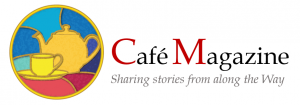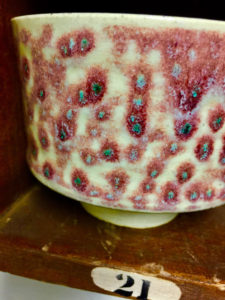
This originally appeared as part of the Daily Sip, a website from Charles LaFond, a spiritual companion, author, potter and fundraiser who lives on the edge of the sea with his dog Kai. offering regular meditations and reflections on spirituality and church fundraising
Pottery is a craft that never ceases to humble one. Humility – the word – comes from “humus” or “earth.” Digging clay, processing it into readiness for the potter’s wheel and then spinning it – twirling it – round and round into a cup is a preposterously vulnerable thing. So many things can go wrong. One could have a stick or stone in the clay. There could be a bubble or soft, or hard lump that will compromise the cup as it spins into existence from the lump by which it began its arrogant climb in status from dirt to tea bowl. The cup could crack as it dries. It could then crack as it is bisque-fired. And finally, there may be something wrong with the glaze. One wonders why the peacefulness of the soil was ever disturbed to make the cup in the first place. But we create. It’s what we do when we are our best selves – take a good museum for example. Some even do it as their worst selves; take the evening news for example.
An artist, collaborating with elements, be they words, clay or paints, is entering vulnerable territory when taking up the tools of the trade to make a new thing. To make a new thing is a vulnerable act that takes enormous courage. And then, even if the book is written or the cup is fired, there are the critics. Critics abound. Artists love them when they adore – hate them when they deplore – despise them when they ignore.
My worst critics in preaching, writing, and pottery are those whose obvious lack of giftedness so infuriates their insecurity that they criticize as an act of self-righteous self-protection. In their heads are the subconscious words “If I push you down then perhaps, I will push myself up.” And perhaps they might, were we not both, critic and artist standing in quicksand. I have been both in my life – the one pushing and the one being pushed. One might as well be wearing a target painted on one’s forehead.
It is time to make pottery for the Christmas shopping season. A potter often begins a throwing day by making tea bowls (“Chowan” in Japanese.) They take about 30 seconds to throw on a wheel and after a dozen or so, one is ready to make the vases of the day. Tea bowls are a warm-up like playing scales for a musician or stretching for a ballerina. The tea bowls are valuable down the line as well, because they serve as good test pots for testing new glazes.

This tea bowl is number 21 in a series. It is heavily mixed with copper and is supposed to coat the cup in a velvety Chinese ox-blood red. But this glaze, this week, on this pot did something extraordinary. It pulled into spots of copper such that the red from the copper carbonate circled raw copper that turned green in its center, crystalline form.
At first, I was appalled. I hated it and was ready to use the potter’s hammer. (Potters unload a kiln with a hammer in one hand to immediately destroy imperfect pieces.) But friends rescued it and asked me to reconsider what I had labeled “failure” – me – my harshest critic. Me, the failure. My glaze, the failure. My Chawan, the failure.
The insecurities of my youth and middle age still persist. However, their accusations seem less shrill, less accusatory, and less abusive these days as my body weakens and my soul strengthens under life’s challenges. Life has a way of humbling even the most arrogant, creating a chemical reaction not dissimilar to the crucible of the potter’s kiln.
In time, I began to like this silly, spotted bowl. A week later, I now quite love its unexpected strangeness and I use this bowl every day for my own tea by the pottery wheel. Spots that just last week seemed like the pustules of plague, now have a Dr. Seuss-ian playfulness about them. Curiosity is such a valuable way to live.
The cup now makes me smile when I drink my tea from its warm walls. Could not the same be said of life? That our criticizing of its unfolding and the critics who show up mercilessly at our door to collaborate with our own thoughts can be kindly invited to sod off? Could we not greet each day with a warmth for the odd, the unexpected, even the seeming “mistake?” Just a bit of waiting, a hug from a friend, or a good night’s sleep might reveal a smile and might inspire us to leave the hammer in the toolbox where it belongs, at least for a while, as things shake out.
So many things can go wrong, not the least of which is our willingness to collaborate with the critics – those at our door and those in our thoughts – and worst of all – both together.
When a thought or critic speaks, I take the words into the inquiry taught to me by my hero Byron Katie:
Is it true?
Can I be absolutely sure it is true?
How do I react when I hear the criticism and feel the anxiety?
Who would I be without both?
The answer to the last question, after hundreds of thousands of times asking these questions in this order – is always the same: “I would be peaceful.” So, let there be peace.
I take up my tea bowl. I sip. I glance over to Kai-the-dog sleeping by the wood stove and I wish I could be a dog. Though I would miss my potter’s hands, I would love a dog’s peace.

